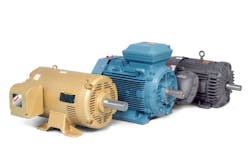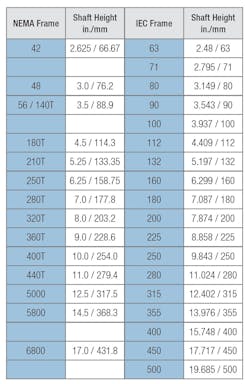When measuring, some use the metric system, and others use the imperial system. The metric system is used in most parts of the world, while the imperial system is used in the U.S. These two standards of measurement can be applied to anything we use. Likewise, we have two standards for electric motors: the National Electrical Manufacturers Association (NEMA motors) and the International Electrotechnical Commission (IEC motors).
NEMA is the North American standard for electric motors. NEMA is the publisher of NEMA MG 1-2014, a book that defines the manufacturing standards for alternating-current (AC) and direct-current (DC) motors in North America. The IEC is the standard for electric motors for the rest of the world. Similar to NEMA, IEC publishes Standard 60034-1:2010, the standard outside North America.
NEMA and IEC motors are similar in size, efficiency and output power. Both also have standards in place to designate:
- Frame size dimensions
- Minimum efficiency levels
- Testing methods
Despite the similarities, electrical and mechanical expectations in the market are sometimes different.
Electrical design
Most low-voltage NEMA motors — less than 600 volts (V) — for North America are designed for 230-, 460- or 575-V, 60-hertz (Hz) systems and are started across the line or with a drive. The IEC standard is a Wye start Delta run (Y/D) winding. Y/D is intended to reduce starting inrush current and can be used with a drive.
A Y/D winding design is possible on NEMA motors but is not common. In addition, NEMA has a voltage variation of ±10 percent while IEC has a variation of ±5 percent. When considering leads, NEMA motors use lead wires for connection while IEC motors use a terminal panel.
From a performance standpoint, the norm for general purpose NEMA motors is NEMA Design B. The design version with a higher inrush current is NEMA Design A. Either design can be classified as the equivalent to IEC Design N.
If an end user needs a motor with a higher starting torque, he or she may turn to a NEMA Design C motor, or the IEC Design H equivalent. NEMA motors usually have a 1.15 service factor, but IEC motors do not typically have a service factor value rating. The service factor value specifies that the motor can be operated at 15 percent above nameplate specifications.
Table 1. NEMA and IEC frame comparison
Mechanical design
In addition to cast iron designs, NEMA motors are available on a rolled steel frame construction, which is common on most open-drip-proof (ODP) motors, and totally enclosed, fan-cooled (TEFC) motors up to 10 horsepower. An ODP style enclosure is extremely uncommon in IEC designs. Most IEC motors are available as TEFC with either finned aluminum or cast iron frames. NEMA motors have conduit boxes located on the sides of the motors (typically referred to as F1 or F2). IEC motors’ conduit boxes are usually at the twelve o’clock position (referred to as F3) and often at the shaft end of the motor.
Testing methods
NEMA three-phase induction motors defer testing to Institute of Electrical and Electronics Engineers Standard 112b and Canadian Standards Association Standard 390-10, while IEC motors’ standard for testing is IEC Standard 60034-2-1. Although they adhere to different standards, both methods are intended to determine the performance of the motor.
Overall, NEMA and IEC motors may be twins, but not identical twins. Though, they both must meet strict design and performance standards with unique requirements targeted at certain industries, regions and markets.
Gamaliel Gonzalez was the product specialist of the General Purpose and Pump Motor line at Baldor Electric Company, a member of the ABB Group. He has worked with Baldor since he graduated with an applied science degree in 2008. He has held positions such as mechanical design engineer and installed base evaluator. Gonzalez has experience in the harsh and demanding applications that the food and beverage and water/wastewater industries demand.
Editor’s note: Effective March 1, 2018, Baldor Electric Company, a member of the ABB group for more than seven years, became known as ABB. Read more here.


